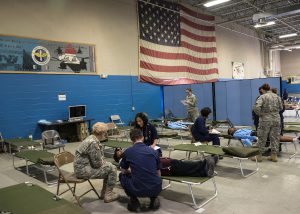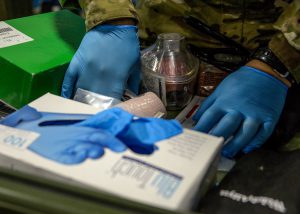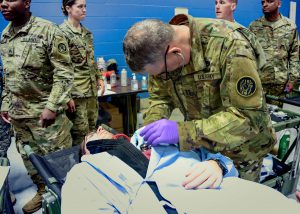Testing the Joint Medical System during natural disaster exercise
[vc_row][vc_column][vc_column_text css=”.vc_custom_1525876747446{margin-top: 0px !important;margin-right: 0px !important;margin-bottom: 0px !important;margin-left: 0px !important;border-top-width: 0px !important;border-right-width: 0px !important;border-bottom-width: 0px !important;border-left-width: 0px !important;padding-top: 0px !important;padding-right: 0px !important;padding-bottom: 0px !important;padding-left: 0px !important;}”]Article By Master. Sgt. Christopher Schepers, 175th Wing Public Affairs Office[/vc_column_text][vc_column_text css=”.vc_custom_1525967597812{margin-top: 0px !important;margin-right: 0px !important;margin-bottom: 0px !important;margin-left: 0px !important;border-top-width: 0px !important;border-right-width: 0px !important;border-bottom-width: 0px !important;border-left-width: 0px !important;padding-top: 0px !important;padding-right: 0px !important;padding-bottom: 0px !important;padding-left: 0px !important;}”] EDGEWOOD, Md. (May 8, 2018) — When a natural disaster strikes, one of the most vital aspects of recovery is treating people that have a medical need in the area. Whether an individual needs immediate medical attention or generic medication, a Joint Medical System provides triage, medical care, and patient holding in response to a natural disaster.
EDGEWOOD, Md. (May 8, 2018) — When a natural disaster strikes, one of the most vital aspects of recovery is treating people that have a medical need in the area. Whether an individual needs immediate medical attention or generic medication, a Joint Medical System provides triage, medical care, and patient holding in response to a natural disaster.
During Vigilant Guard 18 the JMS will be staffed with members of the Maryland Military Department, U.S. Public Health Service’s PHS-2 Rapid Deployment Force, and the Maryland Defense Force.
The exercise will give the groups the opportunity to work together in a training environment so they are better prepared when and if they respond together to a natural disaster.
 “It’s extremely important to work jointly with other components in order to better understand our strengths and weaknesses,” said U.S. Army Maj. Matthew Miskimon, a field surgeon in the 104th Area Support Medical Company. “We can also familiarize ourselves with the policies of other forces and to prepare and practice together and get to know each other in order to more thoroughly and efficiently manage the patient flow and patient treatment.”
“It’s extremely important to work jointly with other components in order to better understand our strengths and weaknesses,” said U.S. Army Maj. Matthew Miskimon, a field surgeon in the 104th Area Support Medical Company. “We can also familiarize ourselves with the policies of other forces and to prepare and practice together and get to know each other in order to more thoroughly and efficiently manage the patient flow and patient treatment.”
Upon entry into the JMS, patients are triaged to determine the extent of their injuries. This gives providers an insight into whether they can treat the patient and if so the course of treatment an individual may need.
 “Patients will be greeted at a triage desk at which point we will determine whether someone has an acute life threatening presentation or are they safe to be signed in to see a provider,” said Miskimon. “The provider that sees the patient will determine whether the patient can be treated for their acute medical problem and then discharged or should they be treated for an illness or medical condition that requires a prolonged observation course.”
“Patients will be greeted at a triage desk at which point we will determine whether someone has an acute life threatening presentation or are they safe to be signed in to see a provider,” said Miskimon. “The provider that sees the patient will determine whether the patient can be treated for their acute medical problem and then discharged or should they be treated for an illness or medical condition that requires a prolonged observation course.”
After treatment, a patient can be sent home or may be admitted to a patient holding area where they can receive additional medical care or stay for an extended period of time.
“We have an acute care area where people get initial treatment,” said Commander Mike Krumlauf, U.S. Public Health Service, PHS-2 Rapid Deployment Force operations director. “If people are going to be here beyond 24 or 48 hours we move them to a less acute area, a more chronic care area.”
People can be moved to the chronic area to help alleviate the crowds at local hospitals or if they are not able to return to their home,” said Krumlauf.
Vigilant Guard is an exercise that allows the Maryland Military Department, along with 42 federal, state, and local agencies a chance to collaborate and test interoperability as part of a national level exercise. The agencies are evaluated on preparing for and recovering from a catastrophic hurricane making landfall. Nearly 2,000 service members, from within the FEMA Region III area, are participating in the Vigilant Guard exercises in Maryland and Virginia. International partners are present observing the exercise to take home lessons learned. The national level exercise is sponsored by the United States Northern Command in conjunction with National Guard Bureau.[/vc_column_text][vc_row_inner css=”.vc_custom_1525968794311{margin: 0px !important;border-width: 0px !important;padding: 0px !important;}”][vc_column_inner width=”1/3″][vc_single_image image=”2775″][/vc_column_inner][vc_column_inner width=”1/3″][vc_single_image image=”2774″][/vc_column_inner][vc_column_inner width=”1/3″][vc_single_image image=”2772″][/vc_column_inner][/vc_row_inner][vc_text_separator title=”View photo gallery from exercise”][vc_raw_html]JTNDYSUyMGRhdGEtZmxpY2tyLWVtYmVkJTNEJTIydHJ1ZSUyMiUyMCUyMGhyZWYlM0QlMjJodHRwcyUzQSUyRiUyRnd3dy5mbGlja3IuY29tJTJGcGhvdG9zJTJGbWRuZyUyRmFsYnVtcyUyRjcyMTU3Njk1OTQ2ODQ3ODA0JTIyJTIwdGl0bGUlM0QlMjJFeGVyY2lzZSUyMFZpZ2lsYW50JTIwR3VhcmQlMjIlM0UlM0NpbWclMjBzcmMlM0QlMjJodHRwcyUzQSUyRiUyRmZhcm0xLnN0YXRpY2ZsaWNrci5jb20lMkY4MjYlMkY0MTA4MTU3NzQyNV85ODczNDBiMzgxX3ouanBnJTIyJTIwd2lkdGglM0QlMjI0MjclMjIlMjBoZWlnaHQlM0QlMjI2NDAlMjIlMjBhbHQlM0QlMjJFeGVyY2lzZSUyMFZpZ2lsYW50JTIwR3VhcmQlMjIlM0UlM0MlMkZhJTNFJTNDc2NyaXB0JTIwYXN5bmMlMjBzcmMlM0QlMjIlMkYlMkZlbWJlZHIuZmxpY2tyLmNvbSUyRmFzc2V0cyUyRmNsaWVudC1jb2RlLmpzJTIyJTIwY2hhcnNldCUzRCUyMnV0Zi04JTIyJTNFJTNDJTJGc2NyaXB0JTNF[/vc_raw_html][/vc_column][/vc_row]
